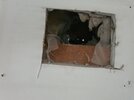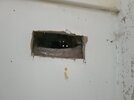I've recently purchased an '80s semi-detached bungalow and currently in the process of renovation.
Originally, the property was heated via a warm air system and water heater, but this was replaced ~10 years ago with a Combi Boiler CH/HW system.
In the kitchen there is a cupboard in which was located two louvred vents. these vents are parallel to two air bricks located on the outside wall. There is no channel or any other kind of means of connection. Simply air brick, cavity, louvre.
The first air brick/louvre vent is located approx ~2 feet from floor level, the second at ~6 feet. There is no evidence that any element of the heating system ever resided in this cupboard (the cabinet for the warm air unit is in the hallway, the cabinet for the water heater is in one of the bedrooms.
There are noticeable signs of damp in the cupboard where these vents were located (jointing tape peeling away from internal corners, paint blistering/peeling) which I assume is due to the proximity of the air bricks to the interior wall.
I assume these did originally serve a purpose of some kind, but are they still necessary? If not, what is the best course of action to seal off the space?


Ta.
Originally, the property was heated via a warm air system and water heater, but this was replaced ~10 years ago with a Combi Boiler CH/HW system.
In the kitchen there is a cupboard in which was located two louvred vents. these vents are parallel to two air bricks located on the outside wall. There is no channel or any other kind of means of connection. Simply air brick, cavity, louvre.
The first air brick/louvre vent is located approx ~2 feet from floor level, the second at ~6 feet. There is no evidence that any element of the heating system ever resided in this cupboard (the cabinet for the warm air unit is in the hallway, the cabinet for the water heater is in one of the bedrooms.
There are noticeable signs of damp in the cupboard where these vents were located (jointing tape peeling away from internal corners, paint blistering/peeling) which I assume is due to the proximity of the air bricks to the interior wall.
I assume these did originally serve a purpose of some kind, but are they still necessary? If not, what is the best course of action to seal off the space?


Ta.

